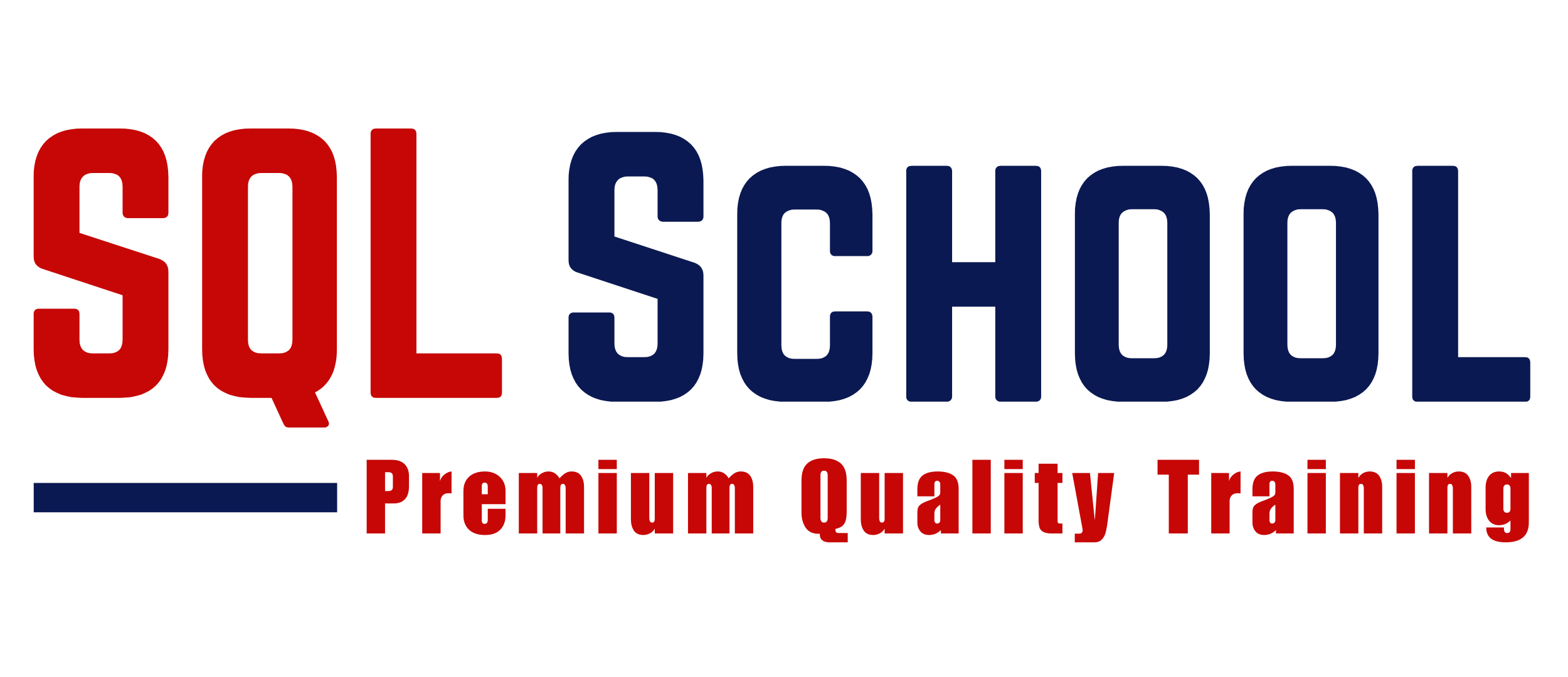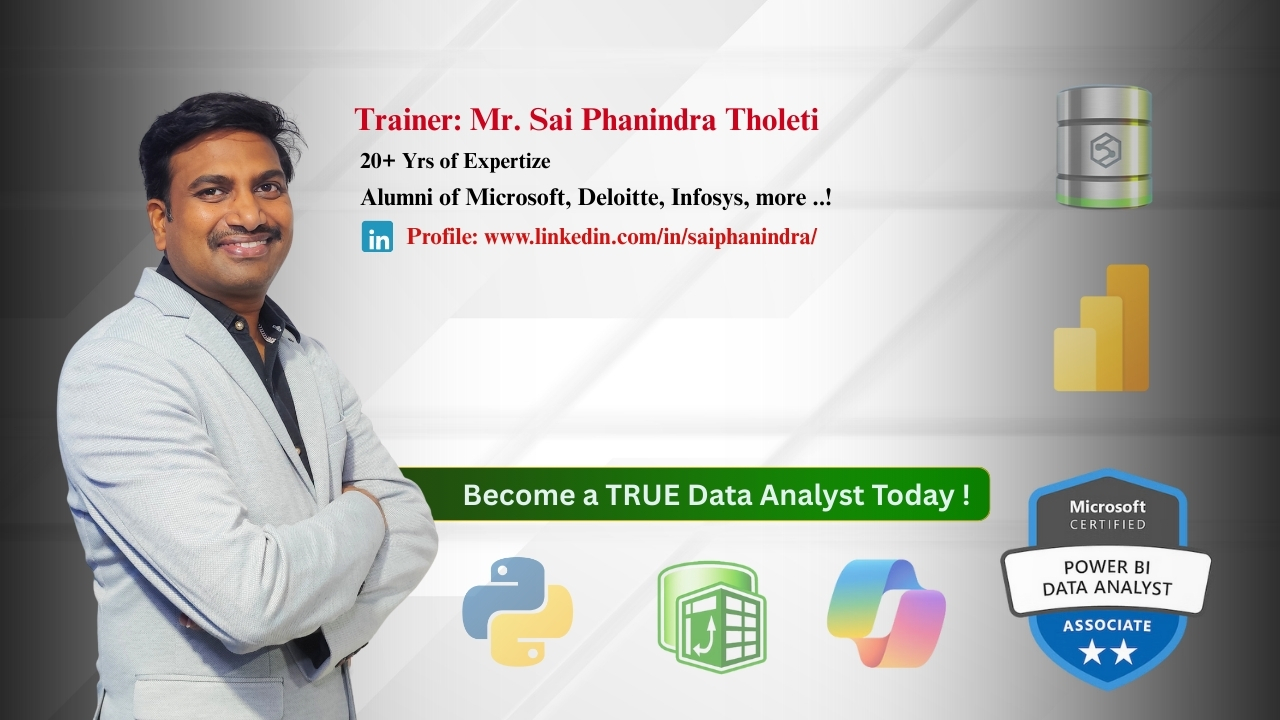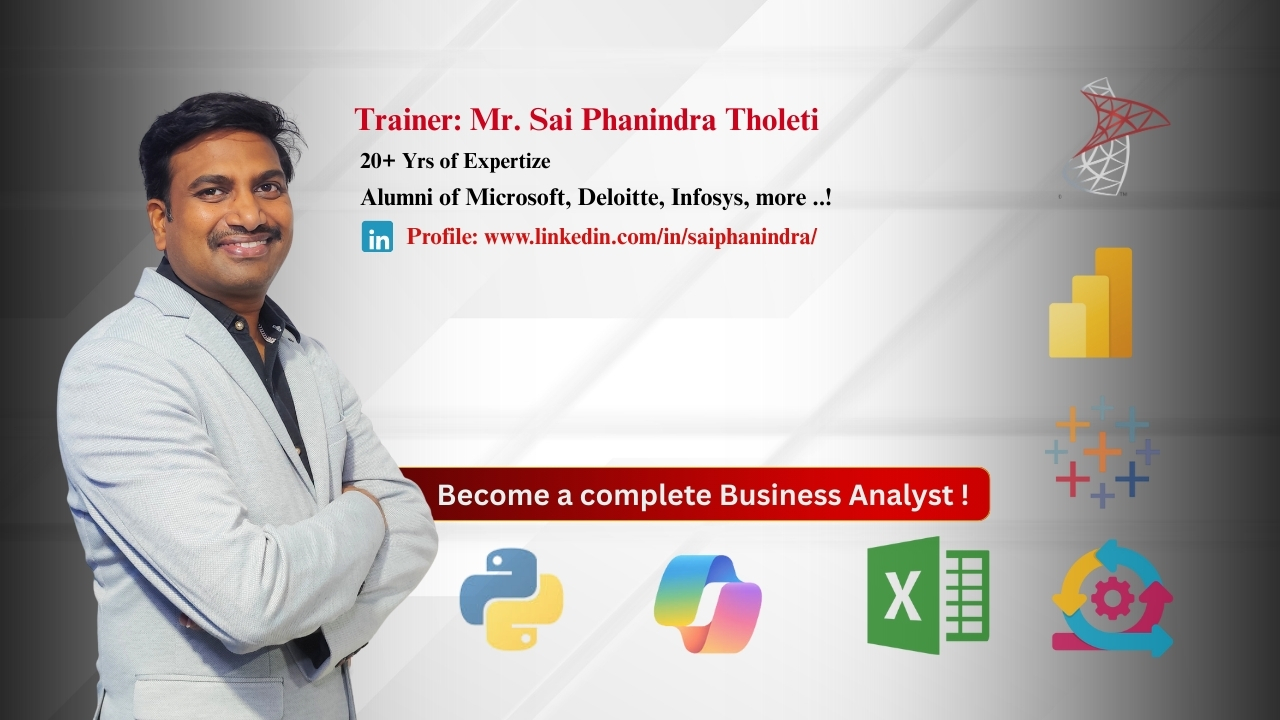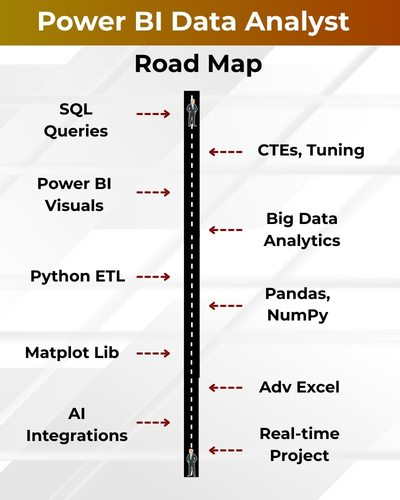
Data Analyst is a promising job role that deals with Data, Analysis, Derived Information and drive to Infographics of enterprise content. This role also involves Data collection, data processing, and data analysis to identify trends, patterns, and relationships that can be used to solve problems and make informed decisions with ease !
✅ SQL for Data Analysis & Reporting
✅ Advanced Excel, Pivot Tables, Dashboards
✅ Power BI for Interactive Visualizations
✅ Data Cleaning with Power Query
✅ Python: Pandas, NumPy, Visualization
✅ Statistics, Exploratory Data Analysis (EDA)
✅ Business Intelligence & Storytelling
✅ Real-Time Projects with Case Studies
✅ Resume Building, Portfolio & GitHub Profile
✅ 1:1 Mentorship & Interview Preparation
Module 1: SQL Server TSQL (MS SQL) Queries
Ch 1: Data Analyst Job Roles
- Introduction to Data
- Data Analyst Job Roles
- Data Analyst Challenges
- Data and Databases Intro
Ch 2: Database Intro & Installations
- Database Types (OLTP, DWH, ..)
- DBMS: Basics
- SQL Server 2025 Installations
- SSMS Tool Installation
- Server Connections, Authentications
Ch 3: SQL Basics V1 (Commands)
- Creating Databases (GUI)
- Creating Tables, Columns (GUI)
- SQL Basics (DDL, DML, etc..)
- Creating Databases, Tables
- Data Inserts (GUI, SQL)
- Basic SELECT Queries
Ch 4: SQL Basics V2 (Commands, Operators)
- DDL : Create, Alter, Drop, Add, modify, etc..
- DML: Insert, Update, Delete, select into, etc..
- DQL: Fetch, Insert… Select, etc..
- SQL Operations: LIKE, BETWEEN, IN, etc..
- Special Operators
Ch 5: Data Types
- Integer Data Types
- Character, MAX Data Types
- Decimal & Money Data Types
- Boolean & Binary Data Types
- Date and Time Data Types
- SQL_Variant Type, Variables
Ch 6: Excel Data Imports
- Data Imports with Excel
- SQL Native Client
- Order By: Asc, Desc
- Order By with WHERE
- TOP & OFFSET
- UNION, UNION ALL
Ch 7: Schemas & Batches
- Schemas: Creation, Usage
- Schemas & Table Grouping
- Real-world Banking Database
2 Part, 3 Part & 4 Part Naming
Batch Concept & “Go” Command
Ch 8: Constraints, Keys & RDBMS – Level 1
- Null, Not Null Constraints
- Unique Key Constraint
- Primary Key Constraint
- Foreign Key & References
- Default Constraint & Usage
- DB Diagrams & ER Models
Ch 9: Normal Forms & RDBMS – Level 2
- Normal Forms: 1 NF, 2 NF
- 3 NF, BCNF and 4 NF
- Adding PK to Tables
- Adding FK to Tables
- Cascading Keys
- Self Referencing Keys
- Database Diagrams
Ch 10: Joins & Queries
- Joins: Table Comparisons
- Inner Joins & Matching Data
- Outer Joins: LEFT, RIGHT
- Full Outer Joins & Aliases
- Cross Join & Table Combination
- Joining more than 2 tables
Ch 11: Views & RLS
- Views: Realtime Usage
- Storing SELECT in Views
- DML, SELECT with Views
- RLS: Row Level Security
- WITH CHECK OPTION
- Important System Views
Ch 12: Stored Procedures
- Stored Procedures: Realtime Use
- Parameters Concept with SPs
- Procedures with SELECT
- System Stored Procedures
- Metadata Access with SPs
- SP Recompilations
- Stored Procedures, Tuning
Ch 13: User Defined Functions
- Using Functions in MSSQL
- Scalar Functions in Real-world
- Inline & Multiline Functions
- Parameterized Queries
- Date & Time Functions
- String Functions & Queries
- Aggregated Functions & Usage
Ch 14: Triggers & Automations
- Need for Triggers in Real-world
- DDL & DML Triggers
- For / After Triggers
- Instead Of Triggers
- Memory Tables with Triggers
- Disabling DMLs & Triggers
Ch 15: Transactions & ACID
- Transaction Concepts in OLTP
- Auto Commit Transaction
- Explicit Transactions
- COMMIT, ROLLBACK
- Checkpoint & Logging
- Lock Hints & Query Blockin
- READPAST, LOCKHINT
Ch 16: CTEs & Tuning
- Common Table Expression
- Creating and Using CTEs
- CTEs, In-Memory Processing
- Using CTEs for DML Operations
- Using CTEs for Tuning
- CTEs: Duplicate Row Deletion
Ch 17: Indexes Basics, Tuning
- Indexes & Tuning
- Clustered Index, Primary Key
- Non Clustered Index & Unique
- Creating Indexes Manually
- Composite Keys, Query Optimizer
- Composite Indexes & Usage
Ch 18: Group By Queries
- Group By, Distinct Keywords
- GROUP BY, HAVING
- Cube( ) and Rollup( )
- Sub Totals & Grand Totals
- Grouping( ) & Usage
- Group By with UNION
- Group By with UNION ALL
Ch 19: Joins with Group By
- Joins with Group By
- 3 Table, 4 Table Joins
- Join Queries with Aliases
- Join Queries & WHERE
- Join Queries & Group By
- Joins with Sub Queries
- Query Execution Order
Ch 20: Sub Queries
- Sub Queries Concept
- Sub Queries & Aggregations
- Joins with Sub Queries
- Sub Queries with Aliases
- Sub Queries, Joins, Where
- Correlated Queries
Ch 21: Cursors & Fetch
- Cursors: Realtime Usage
- Local & Global Cursors
- Scroll & Forward Only Cursors
- Static & Dynamic Cursors
- Fetch, Absolute Cursors
Ch 22: Window Functions, CASE
- IIF Function and Usage
- CASE Statement Usage
- Window Functions (Rank)
- Row_Number( )
- Rank( ), DenseRank( )
- Partition By & Order By
Ch 23: Merge(Upsert) & CASE, IIF
- Merge Statement
- Upsert Operations with Merge
- Matched and Not Matched
- IIF & CASE Statements
- Merge Statement inside SPs
- Merge with OLTP & DWH
Module 2: Power BI with AI, CoPilot
Ch 1: Power BI Intro, Installation
- Power BI & Data Analysis
- 5 Design Tools, 3 Techniques
- 2 Hosting Solutions
- Power BI with Co-Pilot & AI
- Power BI Installation
Ch 2: Report Design Concepts
- Basic Report Design (PBIX)
- Get Data, Canvas (Design)
- Data View, Data Models
- Data Points, Spotlight
- Focus Mode, PDF Exports
Ch 3: Visual Interactions, PBIT
- Visual Interactions & Edits
- Limitations with Visual Edits
- Creating Power BI Templates
- CSV Exports & PBIT Imports
Ch 4: Grouping, Hierarchies
- Creating Groups : Lists
- Creating Groups: Bins
- List Items & Group Edits
- Bin Size & Bin Count
Ch 5: Slicer & Visual Sync
- Slicer Visual in Power BI
- Slicer: Format Options
- Single Select, Multi Select
- Slicer: Select All On / Off
- Visual Sync with Slicers
Ch 6: Hierarchies & Drill-Down
- Hierarchies: Creation, Use
- Hierarchies: Advantages
- Drill Up, Drill Down
- Conditional Drill Down
- Filtered Drill Down, Table View
Ch 7: Filters & Drill Thru
- Power BI Filters
- Basic, Top & Advanced
- Visual Filters, Page Filters
- Report Level Filters, Clear Filter
- Drill Thru Filters & Usage
Ch 8: Bookmarks, Buttons
- Power BI Bookmarks
- Images: Actions, Bookmarks
- Buttons: Actions, Bookmarks
- Page to Page NavigationsScore Cards, Master Pages
Ch 9: SQL DB Access & Big Data
- SQL DB Access, Queries
- Storage Modes: Direct Query
- Formatting & Date Time
- Storage Modes in Power BI
- Azure (Big Data) Access & Formatting
Ch 10: Power BI Visualizations
- Charts, Bars, Lines, Area
- TreeMaps & HeatMaps
- Funnel, Card, Multrow Card
- PieCharts & Waterfall
- Scatter Chart, Play Axis
- Infographics, Classifications
Ch 11: Power Query Introduction
- Power Query (Mashup)
- ETL Transformations in PBI
- Power Query Expressions
- Table Combine Options
- Merge, Union All Options
- Close, Apply & Visualize
Ch 12: Power Query : Table Tfns
- Table Duplicate, Header Promotion
- Group By Transformation
- Aggregate, Pivot Operation
- Reverse Rows, Count Rows
- Advanced Power Query Mode
Ch 13: Power Query: Column Tfn
- Any Column Transformations
- Data Type Detection, Change
- Rename, Replace, Move
- Fill Up, Fil Down
- Step Edits & Rollbacks
Ch 14: Power Query: Text, Date
- String / Text Transformations
- Split, Merge, Extract, Format
- Numeric and Date Time
- Add Column & Expressions
- Expressions and New Columns
- Column From Examples
Ch 15: Power Query: Parameters
- Parameters in Power Query
- Static Parameters, Defaults
- Dynamic Dropdowns, Lists
- Linking with Table Queries
- Step Edits, Type Conversions
Ch 16: Power BI Cloud: Publish
- Power BI Cloud Concepts
- Workspace Creation, Usage
- Report Publish Cloud
- Report Edits in Cloud
- Semantic Models & Usage
Ch 17: Power BI Cloud Dashboards
- Power BI Dashboards
- Dashboard Creation, Usage
- Pin Visuals, Pin LIVE Pages
- Add Image, Video Tiles
- Q&A & Pin Tiles
Ch 18: Power BI Cloud Operations
- Report Shares, Alerts
- Subscriptions, Exploration
- Downloads & Edits
- Report Cloning in Cloud
- QR Codes, Web Publish
- Lineage & Metrics
Ch 19: Power BI Cloud Gateways
- Data Gateways, Data Refresh
- Install, Configure Gateways
- Data Sources Configurations
- Link Datasets to Data Sources
- Data Refresh & Scheduling
- Gateway Optimizations
Ch 20: Power BI Cloud Apps
- Power BI Apps: Creation
- App Sections & Content
- Audience Options
- App Security & Sharing
- App Updates, Favourites
- App URL, End User Access
Ch 21: Power BI Report Server
- SQL Server 2025
- Power BI Report Server
- Report Server Vs Cloud
- Installation, Configuration
- RS Config Tool Options
- Report Database, TempDB
- Web Service & Server URL
Ch 22: Paginated Reports
- Report Builder Tool
- Paginated Report (RDL)
- Report Expressions (RDL)
- Tablix, Chart Wizards
- Fields & Drill-Down
- RDL Report Publish
Ch 23: DAX Concepts (Basics)
- DAX Concepts: Intro & Realtime Need
- DAX Columns: Creation, Use
- DAX Measures: Creation, Use
- DAX Functions: IIF, ISBLANK
- SUM, CALCULATE Functions
Ch 24: DAX Quick Measures
- Quick Measures in Power BI
- Running Totals
- Star Rating Calculations
- DAX Measures in Data View
- DAX in Cloud Reports
Ch 25: Data Modelling, DAX
- Dimensions Tables
- Fact Tables & DAX Measures
- Data Models & Relations
- DAX Expressions
- Star & Snowflake Schemas
- DAX Joins & Expressions
Ch 26: DAX Joins, Variables
- CALCULATEX & Variables
- COUNT, COUNTA, etc..
- SUM, SUMX, etc..
- SELECTED MEMEBER
- Filter Context, RETRUN
- Dynamic Report with DAX
Ch 27: DAX Time Intelligence
- Need for Time Intelligence
- Date Table Generation
- Time Intelligence with DAX
- PARALLELPERIOD, DATE
- CALENDAR, Total Functions
- YTD, QTD, MTD with DAX
Ch 28: DAX – Row Level Security
- RLS: Row Level Security
- Data Modelling & Roles
- Add Cloud Users to Roles
- Dynamic Row Level Security
Ch 29: Analytical Reports
- Analytical Report Concepts
- Excel with Power BI Cloud
- SQL, AVRO, JSON Sources
- Analyse in Excel (Cloud)
- Excel Reports to Cloud
Module 3: End to End Realtime Project - 1
👉 Banking / Finance Domain
👉 Project Requirement
👉 Project Solution (Detailed, Step by Step)
👉 Project FAQs
👉 Mock Interviews
Module 4: AI & CoPilot, Fabric
Ch 1: Copilot Introduction
- AI Concepts
- AI Fundamentals
- AI in Realtime
- Microsoft Copilot
- Realtime Use of Copilot
Ch 2: Copilot Architecture
- Copilot Architecture
- Anatomy of a copilot
- Prompts in Copilot
- Copilot Working
- Data Security
- Copilot Configurations
Ch 3: Building Prompts
- Copilot Usage
- Building Good Prompts
- Dos & Don’ts
- Undo Options
Ch 4: Copilot in Power BI Desktop
- Copilot for Data Modelling
- Copilot for Visuals
- Copilot for Formatting
- Visual Interactions
- Visual Sync
Ch 5: Copilot in Power Query
- Copilot for M Language
- Copilot for ETL
- Copilot with Expressions
Ch 6: Copilot in Power BI Cloud
- Copilot in Cloud Service
- Visual Analytics
- Semantic Models
- Power BI Dashboards
- Power BI Apps
Ch 7: Copilot in DAX
- DAX with Copilot
- Big Data Analytics
- DAX Constructs with Copilot
- Q & A Concepts
Ch 8: Fabric Cloud Concepts
- Fabric Cloud Introduction
- Fabric ETL Topology
- Fabric Advantages
- Fabric Use Cases
Ch 9: Fabric Cloud Operations
- Workspace
- Fabric Warehouse
- Fabric Lake House
- Power BI with Fabric
Ch 4: PL 300 Exam Guidance, CoPilot
- PL 300 Exam (Microsoft Certified Data Analyst) Guidance
- AI Components in Power BI
- CoPilot Practical Uses
- CoPilot with Desktop
- CoPilot with Cloud
- Need for AI Analytics (Fabric)
Module 5: Python (For Data Analysts)
Ch 1: Python Introduction
- Python Introduction
- Python Versions
- Python for Data Analysts
- Python Architecture
Ch 2: Python Installations
- Python Introduction
- Python Installations
- Anaconda Installation
- Python IDE & Usage
- Jupyter Notebooks
Ch 3: Python Print Statement
- Python Print Statement
- print(), print()
- Testing Case Sensitivity
- Single Line, Multi Line prints
- print() with single quotations
- Debug with AI (AI Assistants)
Ch 4: Python Variables
- Python Variables
- Assigning values
- Variable Value Reads
- Multiple Variables & Print()
Ch 5: Python Operators
- Athematic Operators
- Python String Literals
- Single, Double Quotes
- Format Strings (f string)
- Comparison, Indexing Operators
Ch 6: Python Data Types
- Python Data Types
- Integer, Float, String Data Types
- Type Casting
- Type Identification
- Multi Value Assignments
Ch 7: Python Lists
- Creating Python Lists
- Printing List Items
- Print List Slices
Empty Lists, Append - Loops, List Updates
Ch 8: Python Dictionaries
- Python Dictionary
- Indexing Dictionaries
- Edit Key Values
- Lists inside Dictionaries
- Delete & Clear
Ch 9: Python Tuples
- Python Tuples
- Defining, Indexing
- Length(), Type()
- Mixed Values in Tuples
- Overwriting Tuples
Ch 10: Python IF..ELSE Condition
- If..Else conditions
- if..elif..else & Shorthand if
- composite conditions
- Indent, pass statement
- in & negation operators
- range conditions
Ch 11: Python Loops
- Python For Loop
- For Loop @ Range
- For Loop @ Sequence Values
- While Loop, Exit Conditions
- Nested Loops
- Break, Continue, Paas
Ch 12: Python File Handling
- File Handling, Activities
- Loop, Write, Close Files
- Appending, Overwriting
- import os, path.exists
- f.open, f.write, f.close
Ch 13: Python Dataframes
- Dataframes: Creation
- Pandas Dataframes
- Dataframes From Single List
- Dataframes from Dictionary
- Display Dataframes, List Items
- Identify, Replace Nulls, NumPy
Ch 14: Python SQL DB Access
- SQL DB Access with Python
- import pandas.DataFrame
- pyodbc module, sql functions
- SQL Query Executions: DDL, DML
- Filters, Aggregations with SQL
- Dataframe Usage with SQL
Ch 15: Dataframe Transformations – 1
- Dataframe Transformations
- Concat & Append
- Merge Function
- Join with Multiple Dataframes
- Data Type Checks, Conversions
- Loops with Dataframes
Ch 16: Dataframe Transformations – 2
- Pandas – Cleaning Data
- Replace, Transform Columns
- Data Discovery & Column Fill
- Identify & Remove Duplicates
- dropna(), fillna() Functions
Ch 17: Dataframe Transformations – 3
- Python Functions for date, time
- Now() Function in Python
- date, time Functions
- Calendar Data Generation
Ch 18: Python Functions & Lambda
- Python Functions & Usage
- Function Parameters
- Default & List Parameters
- Python Lambda Functions
- Recursive Functions, Usage
- Return & Print @ Lamdba
Module 6: Excel Concepts & Functions
Ch 1: Excel Concepts, Basic Functions
- Excel Basics & Concepts
- Excel Functions
- Excel Operations
Ch 2: Formatting and Proofing
- Currency Format
- Format Painter
- Formatting Dates
- Custom and Special Formats
- Formatting Cells
- Absolute, Mixed
- Relative Referencing
Ch 3: Functions
- SUMIF, SUMIFS, COUNTIF
- COUNTIFS, AVERAGEIF
- AVERAGEIFS, NESTED IF
- IFERROR STATEMENT
- AND, OR, NOT
Ch 4: Protecting Excel
- File Level Protection
- Workbook
- Worksheet Protection
- Security Concepts
- Realtime Issues, Solutions
Ch 5: Text Functions
- Upper, Lower, Proper
- Left, Mid, Right
- Trim, Len, Exact
- Concatenate
- Find, Substitute
Ch 6: Date & Time Functions
- Today, Now
- Day, Month, Year
- Date, Date if, Date Add
- EOMONTH
- Weekday Functions
Ch 7: Adv. Techniques
- Paste Formulas
- Paste Formats
- Paste Validations
- Transpose Tables
Ch 8: New in Excel & 365
- Charts – Tree map & Waterfall
- Sunburst, Box and whisker Charts
- Combo Charts – Secondary Axis
- Adding Slicers Tool in Pivot & Tables
- Using Power Map and Power View
- Forecast Sheet, park lines
Ch 9: New in Excel & 365
- Using 3-D Map
- New Controls in Pivot Table
- Various Time Lines
- Auto complete a data range
- Quick Analysis Tool
- Smart Lookup manage Store
Ch 10: Printing Workbooks
- Setting Up Print Area
- Customizing Headers
- Templates
- Print Titles –Repeat Rows
Ch 11: Sorting and Filtering
- Filtering on Text
- Numbers & Colors
- Sorting Options
- Advanced Filters
- Filter Criteria
Ch 12: What If Analysis
- Goal Seek
- Scenario Analysis
- Data Tables (PMT Function)
- Solver Tool
Ch 13: Logical Functions
- If Function
- How to Fix Errors – if error
- Nested If
- Complex if and or functions
Ch 14: Data Validation
- Number, Date & Time
- Text and List Validation
- Custom validations formulas
- Dynamic Dropdowns
Ch 15: Lookup Functions
- V lookup / H Lookup
- Index and Match
- Smooth User Interface
- Nested V Lookup
- Reverse Lookup
- Worksheet linking
- V lookup with Helper Column
Ch 16: Pivot Tables – 1
- Creating Simple Pivot Tables
- Classic Pivot table
- Choosing Field
- Filtering PivotTables
- Modifying PivotTable Data
- Grouping
- Calculated Fields
Ch 17: Pivot Tables – 2
- Array with IF, LEN
- MID function formulas.
- Array with Lookup functions.
- Various Charts
- SLICERS, Filter data
- Manage Primary Axis
- Manage Secondary Axis
Ch 18: Excel Dashboard
- Planning a Dashboard
- Adding Tables and Charts to Dashboard
- Adding Dynamic Contents to Dashboard
Ch 19: VBA Macro – Level 1
- Using Outlook Namespace
- Send automated mail
- Outlook Configurations, MAPI
- Worksheet Operations
- Workbook Operations
Ch 20: VBA Macro – Level 2
- Merge Worksheets using Macro
- Merge multiple excel files into one sheet
- Split worksheets using VBA
- Worksheet copiers
Module 7: End to End Realtime Project - 2
👉 Banking / Finance Domain
👉 Project Requirement
👉 Project Solution (Detailed, Step by Step)
👉 Project FAQs
👉 Mock Interviews
Module 8: Resume, Job Assistance, PL 300 Exam (Guidance)
✅ Concept wise FAQs, Answers
✅ Project FAQs, Answers
✅ Mock Interviews
✅ 1:1 Resume Meets
✅ Job Placement Assistance
✅ Course Completion Certificate
✅ PL 300 Exam Guidance (Microsoft Certified Data Analyst)
What is the Data Analyst course?
This program trains you to analyze data, build dashboards, use AI tools, write SQL queries, perform ETL, design Power BI reports, and apply Python for data analytics. It is fully job-oriented with 100% hands-on practice.
Who should join this Data Analyst course?
Anyone — freshers, non-IT learners, working professionals, and career switchers. The course starts from basics of data, databases, SQL, analysis, and reporting. No prior technical experience is required.
What are the modules included in this training?
Module 1: MSSQL & TSQL (3 Weeks, 2 Case Studies)
Module 2: Power BI with AI & CoPilot (4 Weeks, 4 Case Studies)
Module 3: Python for Data Analytics (3 Weeks, 1 Case Study)
Module 4: Realtime Projects + Excel + PL-300 + 1:1 Resume + Mock Interviews
Do I need programming knowledge?
No. Programming is not required. Python is taught only for data analytics tasks, not for software development. The entire program is beginner-friendly.
What SQL skills will I learn as part of Module 1?
You will learn SQL basics, commands, joins, constraints, keys, schemas, stored procedures, triggers, CTEs, indexes, grouping, window functions, merge, transactions, and 2 real-time case studies (Medicare & E-commerce).
Will Power BI be taught from basics?
Yes. You will learn Power BI from scratch: Data modelling, visualizations, filters, DAX, Power Query, templates, dashboards, cloud publishing, gateways, apps, and real-time analytics workflows.
Does this course include AI and CoPilot?
Yes. You will learn AI components in Power BI, CoPilot integration, automation, cloud-based CoPilot usage, and how AI enhances BI reporting & analytics.
Do we learn DAX (Data Analysis Expressions)?
Yes. You will learn DAX columns, measures, filters, aggregations, variables, context transitions, time intelligence (YTD, QTD, MTD), RLS security, and real-time reporting.
Is Power Query included?
Yes. You will learn tables, column transformations, text/date/number operations, merges, pivots, parameters, advanced editor, and ETL logic using Power Query.
Does this course include Cloud concepts?
Yes. You will learn Power BI Cloud operations, dashboards, refresh schedules, gateways, reports, apps, security, and cloud user management.
Do we learn Power BI Report Server as well?
Yes. Installation, configuration, report publishing, database setup, server URL, paginated reports (RDL), and report builder usage are included.
Will I learn Advanced Excel as part of this program?
Yes. Excel analytics, data modelling, formatting, SQL/JSON/AVRO integrations, and “Analyze in Excel” using Power BI Cloud are included.
What Python skills will I learn for data analytics?
Python basics, loops, conditions, functions, modules, file handling, error handling, Pandas, DataFrames, cleaning, transformations, duplicates, plotting, and 1 real-time banking/financial case study.
Does the course include real-time projects?
Yes. You will work on multiple real-time projects across E-commerce, Financial Analytics, Healthcare, Banking, and Excel-to-PowerBI analytics scenarios.
Will you help with PL-300 certification?
Yes. Full PL-300 (Microsoft Power BI Data Analyst) exam guidance, mock exams, question practice, and certification strategy are included.
Is 1:1 support available for resume and mock interviews?
Yes. You get personalized resume building sessions, interview preparation, weekly mock interviews, and performance feedback.
Do you provide daily and weekly assignments?
Yes. Daily hands-on assignments, chapter-wise exercises, and weekly mock interviews are part of the training to ensure job readiness.
Is this Data Analyst course suitable for non-IT background students?
Absolutely. The program starts from basic data concepts and gradually moves into SQL, Power BI, DAX, Python, and AI, making it perfect for freshers & non-IT aspirants.
What job roles can I apply for after completing this course?
Data Analyst, Business Analyst, Power BI Developer, SQL Analyst, Reporting Analyst, BI Analyst, MIS Analyst, Data Visualization Engineer, Python Analyst.
What training modes are available for this Data Analyst with AI program?
LIVE Online Training, Self-Paced Video Training, Corporate Training, and Free Demo Sessions with the trainer.
Placement Partners

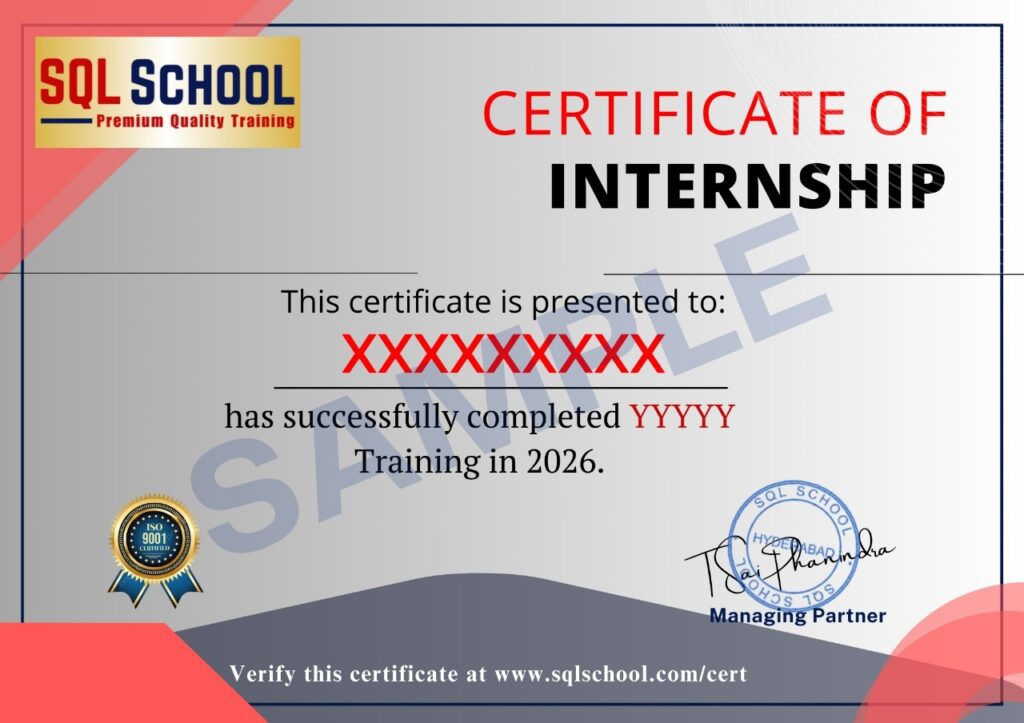
SQL SCHOOL
24x7 LIVE Online Server (Lab) with Real-time Databases.
Course includes ONE Real-time Project.
Why Choose SQL School
- 100% Real-Time and Practical
- ISO 9001:2008 Certified
- Weekly Mock Interviews
- 24/7 LIVE Server Access
- Realtime Project FAQs
- Course Completion Certificate
- Placement Assistance
- Job Support
